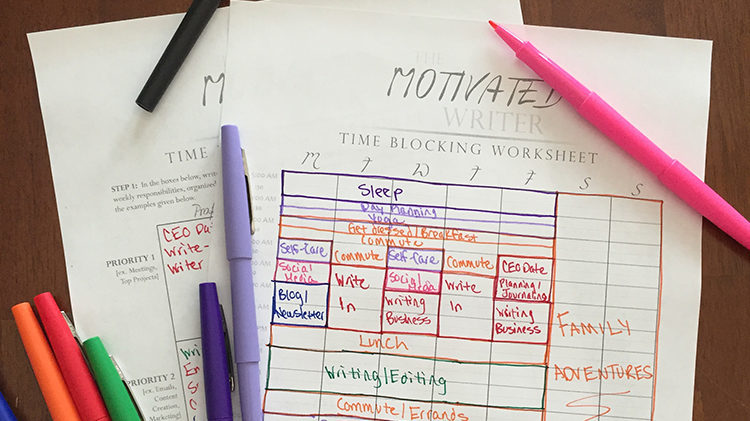One thing I’ve learned about myself over the last few years–and maybe should have figured out a lot sooner–is that I’m not much for schedules. They bore me. I have a feeling this is a common trait of the entrepreneurs and creatives of the world. If we liked schedules, it would be easier to march to the beat of the corporate drum, but instead we resist it, fight against it, and eventually pull away from it to work in a way that is more consistent with our inner rhythms.
Still, I understand that following inner rhythms isn’t always the most reliable way to work. At best, they’re inconsistent. At worst, utter chaos. I’ve lost entirely too much of my life as a writer and as a businesswoman to “not feeling like it right now.” And being in that pattern for too long has often led to feeling lost and unsure about whether I’m making the right choices in my life and my work.
On the other hand, I still like to-do lists and sketching out how and when I’ll be able to get things done. I work better in projects and chunks, though (i.e. knowing it will take me a certain amount of weeks to accomplish a task and then marking out where in my day I can fit it in on a regular basis). But with two kids, my schedule isn’t always up to me, which often leads to stress and frustration.
The Trouble of Working Without a Schedule
The biggest problem I’ve encountered over the last eight or so years without a schedule is lost time. There are a lot of reasons time gets lost:
- Lack of deadlines and accountability
- Lack of progress creates disappointment and a lack of motivation
- “Transition times” end up taking longer than planned for or expected
- Lack of respect for our time from ourselves and others
- Allowing unexpected and unplanned things encroach on our work time
All of these things add up to inconsistency in getting work done, which in turn leads to stress, frustration and more lost time. After too many years spent in this endless cycle, I knew there had to be some kind of middle ground between scheduling myself to death and floating whichever way the wind blew me.
A More Flexible Method
So I intuitively started to so something that I later found out was called “Time Blocking.” The idea is that you schedule your days in chunks, marking off large time periods for certain types of work, but leaving the details of what work you’ll accomplish more open. For instance, here is the time blocking schedule I’ve recently devised for myself:

At first glance, this might seem like a lot of scheduling, but marking off blocks actually gives me more freedom because I don’t over-schedule myself so much anymore. I know roughly how much I can get done in each time block so when I make commitments to other people, I can be more realistic about what I can actually accomplish. Plus, if something takes longer than I expect it to, I can set it aside, continue on with my blocks, and more easily find a place to squeeze in the remainder later.
Here are the things I love most about blocking like this:
- I know what to expect throughout the day and so does my family
- It’s balanced and includes all the things that are important to me
- It makes work a priority without letting it take over my entire day
- Each block ends up feeling longer than you’d think because little transition time (i.e. figuring out what the heck I’m doing next) is lost
- Within each block, I’m free to prioritize what makes sense for the day
- I don’t waste working time worrying about when or how I’m going to get everything done
- It’s easy to shift blocks around as my family’s schedule changes or new things become a priority
And please know that my life is not a perfectly oiled machine and never will be, just as no one else’s life is. This is my ideal and by working like this as much as possible, I get a lot accomplished. Then, when life gets in the way, I’m don’t worry too much about about the lost productivity. I just jump back into the rhythm as quickly as I can.
Tips for Creating Your Own Time Block Schedule
If you think using a Time Blocking method would work for you, here are some tips that might help you outline your day in a way that’s inspiring and empowering to you:
- First, start by making a list of everything that’s important to you and everything you’d like to accomplish in a day. Don’t forget the little things like getting dressed, or the familial responsibilities like cleaning and homework. (There is a section for this in my Time Blocking Worksheet–more details below.)
- Then, group those items into similar categories (categories I use are writing/editing, writing business, social media, family, chores/errands, reading, self-care, exercise, etc.) and give each category a priority.
- Print out a day scheduler, grab a blank sheet of paper, or download my Time Blocking Worksheet, and start marking out chunks, or “time blocks”–things with specific times should go first, like wake up times, lunch, dinner, bed times, work, school, etc. After that, start with the highest priority items and fill them into the most productive times of your day. Keep filling until you have everything on your list into your schedule.
- Be realistic about how long things will take you, or even pad it if you can. If you’re just scrambling to cram everything in, the purpose of time blocking is lost. If you end up with more time than necessary, you’ll feel on top of things and can take a few minutes to relax throughout the day.
- Use a timer or reminders on your phone to keep you on track. I like the 30/30 Timer because you can fill in your entire time block schedule and set it to repeat every day. You’ll get a little ding to let you know it’s time to switch to your next block.
- Stick to it. Even if you don’t get everything done you hoped to during a block, set aside when the timer is up. There’s always tomorrow’s block and you owe it to yourself to live a balanced day. If you’re consistently running behind in any one block, make adjustments.
- Re-assess often. Especially when you first start using this method, when you aren’t sure what to expect. As you better learn to organize your days in this manner, you’ll better understand how to fit all your top priorities in. You’ll also discover when certain times of day are better suited for certain types of work. But at minimum, be sure to re-design your day whenever your schedule changes (i.e. you get a new job, kids are home for summer break, etc.). You can even do this simply because you’re bored and want to shake things up–I often do!
Since using this time blocking method, I’ve felt a lot more in control of my days and I accomplish a lot more on a regular basis while also giving myself and my family the time needed to stay connected to what matters most to me. Even more rewarding, I have shared this method and worksheet with many writers over the years and it’s so great to see that click happen when they realize they have more time in their day to write than they thought. I hope you’ll find the same happens for you!
Get Your Time Blocking Worksheet
If you’d like a copy of the Time Blocking Worksheet I created (pictured above) you can do so by subscribing to my newsletter below, which includes writing tips, access to all my free writing tools, and other writerly inspiration! Or, if you’d prefer not to subscribe, you can email me for a copy using my Contact page.
Wishing you a productive week!




Interesting you would post this now. 🙂 I’ve struggled with scheduling since I decided to begin my writing career years ago. I’ve tried everything imaginable to get a system in place. It doesn’t help that I have a full time job to work around, but you have to do what it takes to keep a roof over your head and food in the mouth, lol.
I’ve recently got more in tuned with the methods which are working, for now anyways. I have a system set in place inspired by part Miracle Morning/part Getting Things Done. This has really freed my mind up to the point of finally getting back to my creativity.
But even with all this, I still lose time deciding what to do during my days off to be more production. (My work days only give a few hours in the morning and a few in the evening, so I just stick with the most important task at that moment.) The Block Schedule may up my progress on those days off. So, thank you for that tip.
Have a great weekend.
It has taken me many, many years to get to a point where I feel like I’ve truly got a routine that works for me and keeps me productive. I just continued to try new things, slowly but surely figuring out what works well for me and what doesn’t. Sounds like that’s been working for you too!
I LOVE Miracle Morning! One of my favorite productivity books. Yes, hopefully you can add this to your arsenal. One other thing I do, is have a to-do list for the week and figure out roughly which day I will accomplish each task. Maybe it would help you to do the same and plan a little further in advance? Either way, I hope you’re able to perfect your system!
Thanks for the added tip. I have the very bad habit of creating a to-do list the morning of my day off that can’t possibly be completed and then beat myself up when I don’t get it all done. I’m determined to knock that bad habit in the dust. 🙂
[…] Use time blocking to plan out the writing schedule. If you’ve never crafted a blog post, you’ll find that it takes about 2 – 3 hours of focused work for each 1200 words written. This different from novel writing, which (for me) happens at a much slower average rate, because the post contains the whole story. There is plot to reconfigure. No new character jumps out of nowhere and onto your page, forcing a (satisfying) re-write of several already-completed chapters. […]